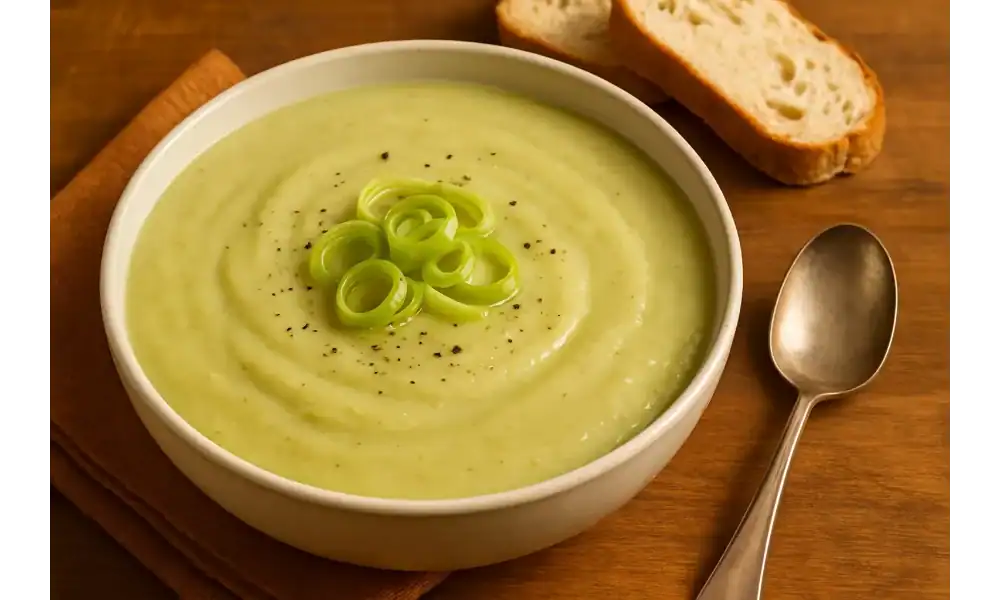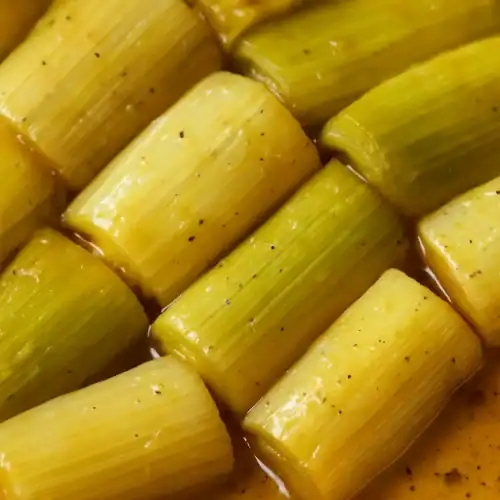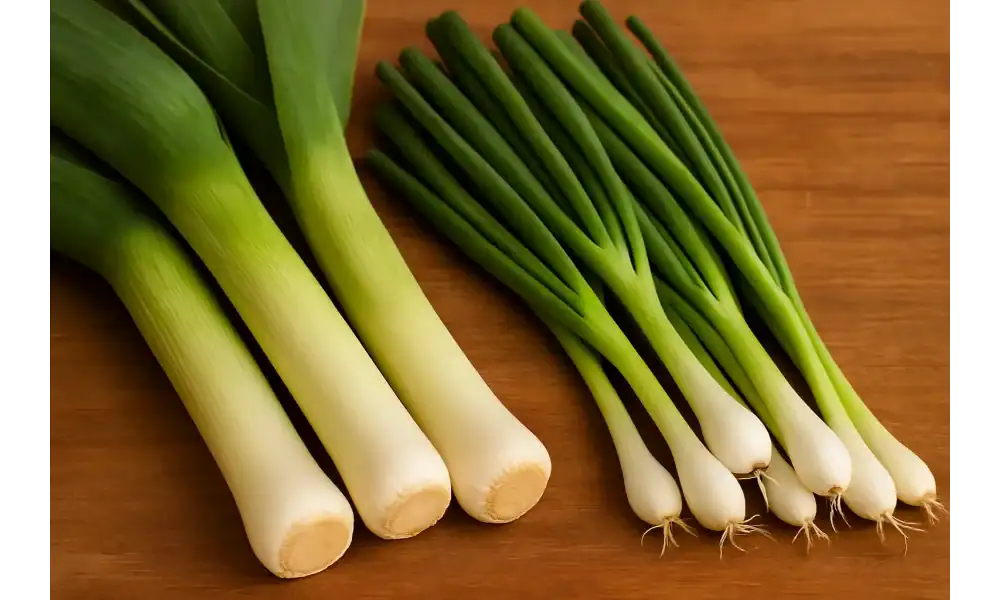Introduction
Cooking with leeks vs green onions shows just how different these two look-alike veggies really are. Leeks have a mild, sweet flavor and work well in warm, comforting dishes. Green onions, on the other hand, are sharper and crisper—ideal for quick, fresh recipes.
Leeks have a mild, sweet flavor. Green onions, also called scallions, taste sharper and more herbal. They may look alike at first, but their textures, sizes, and uses can change the outcome of a dish.
Many cooks confuse the two. Some recipes even use them as substitutes. But knowing the difference helps you cook better. It also helps you pick the right one for your flavor and texture goals.
French cooking often uses leeks. Asian dishes love green onions. Both have their place in the kitchen. And both can make your food taste great when used the right way.
In this guide, we’ll break down leeks vs green onions. We’ll show you when to use each one—and why it matters.
If you are a leek lover, try our:
10 Easy and Delicious Leek Recipes You’ll Want to Make Again
Understanding the Basics – What Are Leeks and Green Onions?
Leeks and green onions may look alike, but they are different in structure, taste, and use. Both belong to the allium family, which also includes garlic, shallots, and regular onions. Let’s look at what makes each one unique.
What Are Leeks?
Leeks are long and thick. They have a white base and wide green leaves. Their flavor is mild, sweet, and less sharp than other onions. You usually cook leeks in soups, stews, or sautés. Use only the white and light green parts—those are tender and full of flavor.
For more insights about this vegetable, click here!
What Are Green Onions (Scallions)?
Green onions are thinner and more delicate. They have a white base and narrow green tops. You can eat the whole stalk—both white and green parts. Their flavor is stronger than leeks and works well raw or lightly cooked. People often sprinkle them over salads, noodles, or eggs.
For more details, click here!
What Is the Allium Family?
Leeks and green onions belong to the allium family. This group includes flavor-packed vegetables like onions, garlic, and chives. Alliums bring depth and aroma to many dishes around the world. Each one has a unique role in the kitchen.
Key Visual Differences
Leeks are larger, with a thick base and flat, dark green leaves. Green onions are slim, with round stalks and a lighter green color. Leeks grow taller and are tougher. Green onions are shorter, softer, and easier to chop.
Leeks vs Spring Onions vs Scallions
Many people confuse green onions, scallions, and spring onions. Scallions and green onions are the same. Spring onions look like green onions but have small bulbs and a stronger taste. Leeks vs green onions is a common comparison, but each has its own place in cooking.
Flavor Profile and Cooking Uses

Leeks and green onions taste different, so they work best in different dishes. Let’s look at how each one adds flavor to your food and when to use them.
Leek’s Mild, Sweet Onion Flavor
Leeks taste soft and sweet. They don’t overpower a dish. Their flavor builds slowly as they cook. That’s why many chefs use leeks in creamy or rich meals. They add a smooth onion taste without the sharp bite.
Green Onion’s Sharper, More Herbaceous Taste
Green onions taste bolder and fresher. They give dishes a sharp, green flavor. The white part is stronger, while the green tops are milder and more herb-like. They add brightness and crunch, especially when used raw.
When to Use Leeks in Soups, Stews, and Sautés
Use leeks when cooking warm, slow meals. They work well in soups, stews, quiches, and sautés. Try them in potato leek soup or braised dishes. Their soft texture blends well into the dish as they cook down.
Best Ways to Use Green Onions in Stir-Fries, Salads, Garnishes
Use green onions for quick meals. They’re great in stir-fries, noodle bowls, scrambled eggs, and tacos. Add them raw to salads or sprinkle on top as a garnish. Their crisp texture and bold flavor make dishes pop.
How Their Flavors Change When Cooked vs Raw
Leeks get softer and sweeter when cooked. They melt into dishes. Green onions lose some sharpness when heated but stay fresh and light. Raw, they bring a strong onion kick. Cooked, they mellow out just enough.
Nutritional Value and Health Benefits
Both leeks and green onions offer great health benefits. They’re low in calories but rich in nutrients. Let’s break down how each one supports your health.
Calories, Vitamins, and Fiber Content
Leeks and green onions are low in calories. One cup of chopped leeks has around 54 calories. Green onions have about 32 calories per cup. Both are rich in vitamin K, vitamin C, and folate. They also provide fiber, which helps you feel full and supports digestion.
Antioxidants in Green Onions
Green onions contain antioxidants like quercetin and flavonoids. These fight free radicals and help reduce inflammation. Eating green onions may boost your immune system and protect your cells from damage.
Leeks’ Role in Gut Health and Digestion
Leeks contain prebiotics, which feed good gut bacteria. This helps keep your digestive system healthy. They also contain a compound called inulin that improves bowel function and boosts nutrient absorption.
Low-Calorie, High-Flavor Option
Both veggies add flavor without adding fat. You can use them to boost taste while keeping calories low. They’re perfect for anyone watching their weight or eating clean.
Heart-Healthy Compounds in Both
Leeks and green onions support heart health. They contain allicin and other sulfur compounds. These may help lower cholesterol and blood pressure. Adding either to your diet can support long-term heart health.
Cooking Techniques and Recipe Suggestions

Leeks and green onions need different prep and cooking methods. Each one shines in its own way. Here’s how to cook with them and some tasty ideas to try.
How to Clean and Prep Leeks Properly
Leeks grow in sandy soil, so dirt hides in the layers. First, cut off the root and dark green tops. Slice the white and light green parts. Then place them in a bowl of water and swish them around. The dirt will sink. Rinse well before cooking.
Cooking Green Onions Quickly for Fresh Flavor
Green onions cook fast. Slice them and add to a hot pan for just a few seconds. Stir-fry them with noodles or toss them into eggs. You can also use them raw for a crisp, bold flavor in salads or tacos.
Leek-Based Dishes: Potato Leek Soup, Quiche, Braised Leeks
Leeks work best in soft, warm meals. Try them in potato leek soup or a cheesy quiche. For a side dish, braise them with butter and herbs. Their mild flavor pairs well with rich, creamy ingredients.
Green Onion-Based Dishes: Scallion Pancakes, Fried Rice, Egg Drop Soup
Green onions add punch to quick dishes. Make scallion pancakes for a crispy snack. Stir them into fried rice or sprinkle over egg drop soup. They’re also great as a fresh topping for ramen, tacos, or baked potatoes.
Substitutions and When They Can Replace Each Other
You can swap them in some recipes. Use green onions in place of leeks for a sharper, lighter taste. Use leeks if you want a softer texture in soups or casseroles. Just remember: leeks cook longer and taste milder.
Which One to Choose and When?
Choosing between leeks and green onions depends on what you’re cooking. Think about flavor, cooking time, and the style of your meal. Here’s how to decide.
Use Leeks for Creamy, Hearty, or Slow-Cooked Meals
Leeks taste best when cooked slowly. They work well in creamy soups, rich casseroles, or baked dishes. Their sweet, mellow flavor blends nicely into comfort food. Use them when you want depth without the sharpness of regular onions.
Use Green Onions for Light, Fast, and Fresh Dishes
Green onions are great for quick meals. Add them to stir-fries, salads, or wraps. They bring a bold, fresh bite. Use them raw or lightly cooked to keep their flavor bright and sharp.
Cuisine-Specific Uses (French vs Asian Cooking)
French dishes often feature leeks. They show up in quiche, gratins, and soups. On the other hand, green onions are staples in Asian meals. Think scallion pancakes, ramen toppings, or fried rice. Choose based on the cuisine you’re making.
Availability and Cost Comparison
Green onions are usually cheaper and more common in stores. You’ll find them year-round. Leeks can cost more and take up more space. Still, both are affordable ways to add flavor without extra calories.
Tips for Growing or Storing Them at Home
You can grow both in your backyard or in pots. Green onions regrow easily in water. Just place the roots in a glass and leave them near a window. Leeks take longer but grow well in cool soil. Store both in the fridge and use within a week.
Braised Leeks in Sauce

Braised Leeks in Sauce
Ingredients
Method
- Instructions
- Trim and clean the leeks. Slice them in half lengthwise, then cut into 3-inch pieces. Rinse well to remove dirt.
- Heat oil in a large skillet over medium heat. Add leeks cut-side down. Cook for 3–4 minutes until lightly golden.
- Flip leeks, season with salt, pepper, and thyme.
- Add broth and bring to a gentle simmer. Cover with a lid.
- Braise for 15–20 minutes until the leeks are soft and the sauce has reduced.
- Uncover and add lemon juice if using. Let cook 2–3 more minutes to thicken slightly.
- Serve warm with sauce spooned on top.
FAQs
1. Can I use green onions instead of leeks?
Yes, but it depends on the dish. Green onions are sharper and better raw or lightly cooked. Use them in place of leeks in quick meals, but not in creamy or slow-cooked recipes.
2. Are leeks and green onions from the same plant family?
Yes. Both belong to the allium family, which also includes garlic, onions, and chives.
3. What part of the leek do you eat?
You eat the white and light green parts. The dark green tops are too tough but can be used to flavor stock.
4. What dishes are best with leeks?
Try leeks in potato leek soup, quiche, or braised with herbs and butter. They work best in warm, rich dishes.
5. What’s the difference between scallions and green onions?
There’s no difference. Scallions and green onions are the same thing—just different names.
Conclusion
Leeks and green onions look similar, but they taste and cook very differently. Leeks are sweet, soft, and perfect for warm, hearty dishes. Green onions are sharp, crisp, and best in fast, fresh meals.
Use leeks in soups, quiches, and slow-cooked recipes. Add green onions to stir-fries, salads, and as a topping. They both come from the same family, but they shine in their own ways.
Try switching them in your favorite recipes. You’ll discover how each one changes the flavor and texture. That’s the fun of cooking—experiment and taste as you go.
Cooking with leeks vs green onions doesn’t have to be tricky. Just match the right one to your dish. You’ll enjoy better results and more flavor in every bite.
For more recipes, try our:

